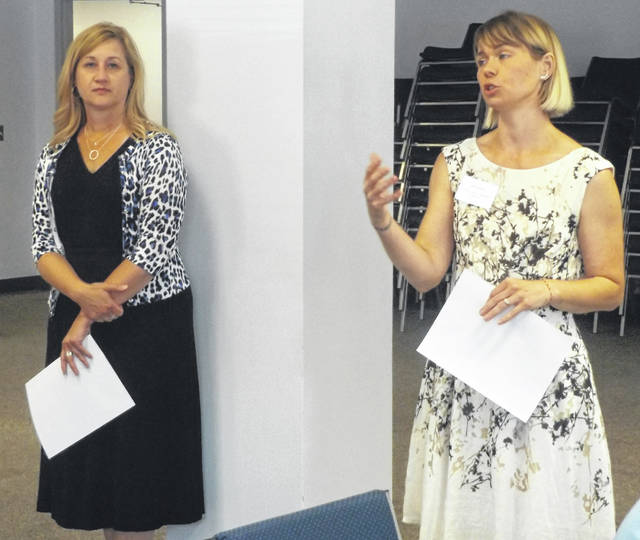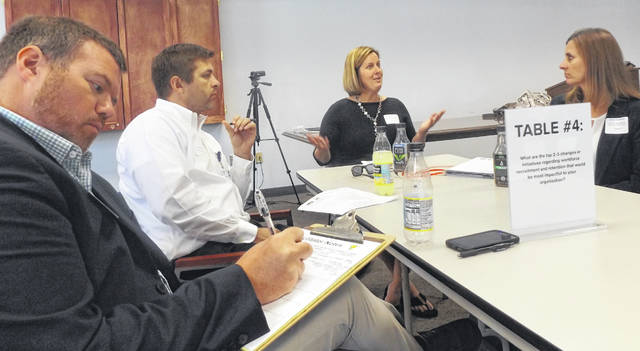

WILMINGTON — It’s no small matter: How do we in Clinton County make it more likely local employers can draw the talent they need, and how do we see to it that job seekers here have the skills they need in their working lives?
A “Clinton County Workforce Roundtable” meeting was held Wednesday as an initial step in a new initiative to address, in a concerted manner, local workforce challenges and gaps.
This first meeting was intended to help local employers and area educators better understand what resources are available and what the workforce needs are. A clearer direction for how to deal with the particular local circumstances, organizers expect, will emerge as this workforce development effort keeps up.
One theme that was heard Wednesday is that local schools can help connect the area’s young people with local business.
A representative of the Southwestern Ohio Council for Higher Education (SOCHE) encouraged employers to use interns — both high school and college — “as a way to build your future pipeline [of employees].”
The SOCHE representative also encouraged businesses to pay interns because insisting on free interns significantly limits the pool of youths who can work as an intern, she said.
United Way of Clinton County President Amanda Harrison said she’s been talking with her Warren county counterpart about a relatively new project there, and looking at its possibilities for Clinton County.
United Way would partner with local businesses so that youths would better understand what jobs there are in the area, and the project would include learning what training is needed for the jobs. The idea is for the young person to start part-time or as a temp worker their senior year, and then by the time they graduate they have the needed training and skills and could go full-time with benefits after graduation.
The SOCHE representative said she is a firm believer that exposing high school students to different opportunities is a must.
Wilmington City Schools (WCS) Superintendent Mindy McCarty-Stewart said when she conducts exit interviews, she finds that lack of local housing is an issue.
Commuting, say for 45 minutes to an hour, is the number one reason people give for leaving, she said.
McCarty-Stewart took the opportunity to promote WCS as a strong reason to live — and hence work as well — in the Wilmington area. She said she loved raising her kids in Wilmington schools, citing their size, that they offer some diversity, and the performing arts.
As for the Wilmington area itself, she said positives include a tight-knit community, the college, being able to purchase a home with some land because there’s more bang for your buck here, plus “you’re not in some of the rat race of some of those other communities.”
One Workforce Roundtable participant said good schools not only can be a magnet for a person to decide to reside in a certain school district, but said he thinks schools have a significant opportunity for creating community.
He said he thinks schools are the last bastion of community in most small towns, adding that it used to be churches but they have lost influence.
Clinton County Regional Planning Commission Executive Director Taylor Stuckert favors investing in schools and making sure they have the resources they need to be successful.
He also supports investing in community amenities in order to effectively recruit and retain local employees.
A representative of an area manufacturer said a lot of its newly hired management typically does not even look around the Wilmington area to find a residence. Instead, they look at Miamisburg or places like that where they say there is more to do, he said.
During a summary report detailing the small-group he facilitated during the meeting, Curt Bradshaw of the Southern Ohio Educational Service Center in Wilmington listed needs that were identified to improve workers’ attraction to the area. He said those include: high-speed internet access; transportation options especially for those who live or work outside Wilmington; housing opportunities; and more affordable childcare that is also trustworthy and reliable.
The Workforce Roundtable is an initiative of the Clinton County Port Authority, OhioMeansJobs Clinton County, Southern Ohio Educational Service Center, and the Wilmington-Clinton County Chamber of Commerce.
Reach Gary Huffenberger at 937-556-5768.



